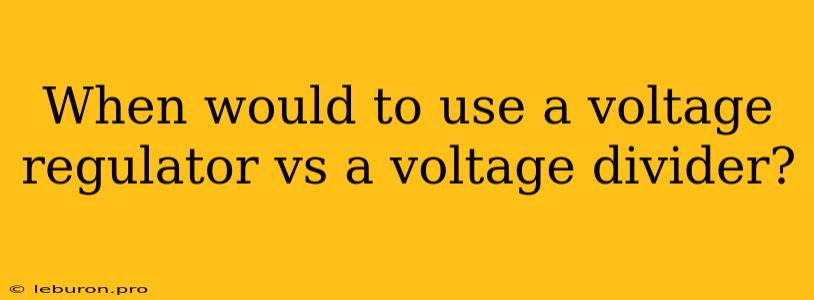In the realm of electronics, regulating voltage is crucial for ensuring proper operation of circuits and devices. Voltage regulators and voltage dividers are two common methods employed to achieve this goal. While they share the objective of manipulating voltage levels, their principles of operation, applications, and characteristics differ significantly. Understanding the key distinctions between voltage regulators and voltage dividers is essential for selecting the appropriate technique for a given scenario. This article will delve into the intricacies of each method, highlighting their respective strengths, limitations, and suitability for different applications.
Voltage Regulators: The Guardians of Stable Voltage
Voltage regulators are active electronic circuits designed to maintain a constant output voltage regardless of fluctuations in the input voltage or changes in load current. They achieve this by actively monitoring the output voltage and adjusting the input voltage accordingly to compensate for variations. Voltage regulators are typically implemented using transistors, operational amplifiers (op-amps), or specialized integrated circuits (ICs).
Types of Voltage Regulators
There are two primary types of voltage regulators: linear regulators and switching regulators.
Linear Regulators:
- Operation: Linear regulators work by dissipating excess voltage as heat. They essentially act like a variable resistor, adjusting their resistance to maintain a constant output voltage.
- Advantages: Simple design, low noise, and low cost.
- Disadvantages: Inefficient due to heat dissipation, limited output current, and low power efficiency.
- Applications: Low-power applications, where noise is a concern and efficiency is not a major factor.
Switching Regulators:
- Operation: Switching regulators use high-frequency switching elements to convert the input voltage to the desired output voltage. They operate with higher efficiency, transferring energy more efficiently than linear regulators.
- Advantages: High efficiency, high output current, and wide input voltage range.
- Disadvantages: More complex design, potential noise generation, and higher cost.
- Applications: Applications requiring high power, efficiency, and wide input voltage ranges.
Voltage Dividers: Simple Voltage Scaling
Voltage dividers, on the other hand, are passive circuits that use a series combination of resistors to divide an input voltage into a smaller output voltage. They operate based on the principle of voltage division, where the output voltage is proportional to the ratio of the resistors in the divider.
Understanding Voltage Division
A voltage divider consists of two resistors, R1 and R2, connected in series. The input voltage is applied across the series combination, and the output voltage is taken across R2. The output voltage (Vout) is calculated using the following formula:
Vout = (R2 / (R1 + R2)) * Vin
This formula indicates that the output voltage is directly proportional to the value of R2 and inversely proportional to the sum of R1 and R2. By adjusting the values of R1 and R2, we can control the output voltage.
Advantages and Disadvantages of Voltage Dividers
- Advantages: Simple design, low cost, and easy to implement.
- Disadvantages: Fixed output voltage, susceptible to load variations, and limited power handling capacity.
When to Choose a Voltage Regulator vs. a Voltage Divider
The choice between a voltage regulator and a voltage divider depends on the specific application requirements. Here's a summary of key considerations:
Choose a voltage regulator when:
- Stable output voltage: A voltage regulator is crucial when a stable and constant output voltage is required, irrespective of input voltage or load variations.
- High power applications: For applications requiring high power, switching regulators offer high efficiency and can handle significant current loads.
- Noise reduction: Linear regulators generally produce lower noise compared to switching regulators.
Choose a voltage divider when:
- Simple voltage scaling: When a fixed output voltage is needed and load variations are minimal, a voltage divider is a suitable option.
- Low-power applications: For low-power applications, where efficiency is not a primary concern, a voltage divider can be cost-effective.
- Minimal load variations: Voltage dividers work best when the load on the output is relatively constant.
Illustrative Examples
Let's consider some real-world scenarios to illustrate the use cases of voltage regulators and voltage dividers:
-
Example 1: Powering a microcontroller: Microcontrollers often require a stable voltage supply for reliable operation. A voltage regulator is used to convert a higher input voltage from a battery or power supply to a lower, regulated voltage suitable for the microcontroller.
-
Example 2: Reducing voltage for an LED: LEDs have a specific forward voltage they need to operate correctly. A voltage divider can be used to reduce the voltage from a higher supply to the appropriate level for the LED.
-
Example 3: Creating a reference voltage: Voltage dividers are often employed to create reference voltages for analog circuits or sensors. The output voltage of a voltage divider can provide a stable reference for other circuit components.
Conclusion
In conclusion, voltage regulators and voltage dividers are essential tools for manipulating voltage levels in electronic circuits. Voltage regulators offer a stable and regulated output voltage, while voltage dividers provide simple voltage scaling. The choice between the two depends on the specific application requirements, including the desired output voltage stability, power requirements, noise considerations, and load variations. By carefully evaluating these factors, engineers can select the most appropriate voltage regulation technique to ensure optimal performance in their electronic designs.
